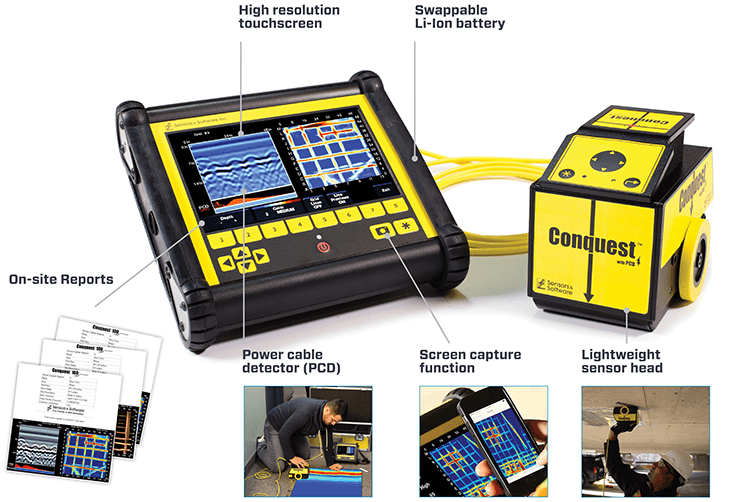RainierGPR Service Areas: Comprehensive Coverage for Concrete Scanning
RainierGPR Service Areas: Comprehensive Coverage for Concrete Scanning
Blog Article
Concrete Scanning: An Important Step In The Direction Of Ensuring Structural Stability and Safety And Security
In the world of building and construction and facilities maintenance, the importance of concrete scanning can not be overemphasized. By utilizing sophisticated technology and techniques, concrete scanning serves as a crucial tool in guaranteeing that the stability and security of structures and bridges are promoted to the greatest requirements.
Value of Concrete Scanning
Concrete scanning plays a crucial duty in making sure the structural honesty and security of structures and framework projects. By making use of innovative innovations such as ground-penetrating radar (GPR) and electro-magnetic induction, specialists can non-destructively check concrete frameworks to find possible defects, voids, embedded things, and reinforcement design. This procedure enables very early discovery of anomalies that might jeopardize the stability of a structure, protecting against costly problems and ensuring the safety of owners.
Concrete scanning is especially crucial throughout the planning and construction phases of a job. Prior to drilling, cutting, or coring into concrete, scanning aids identify the exact places of rebar, post-tension cable televisions, and other ingrained components, minimizing the threat of accidental hits that might bring about structural weak points. Additionally, concrete scanning aids in quality assurance by verifying the thickness of concrete covers and identifying any kind of disparities that may impact the general resilience of the framework. Eventually, buying concrete scanning services is not just a proactive measure to mitigate dangers however additionally a fundamental action towards maintaining the lasting security and stability of structures and infrastructure.
Technology for Concrete Evaluation

Benefits of Very Early Detection
Timely detection of structural issues can substantially minimize dangers and make sure the long life of building and construction projects. By recognizing possible problems early in the building and construction procedure, stakeholders can take aggressive steps to address concerns before they rise into bigger and extra pricey issues. special info Among the vital advantages of early detection is the prevention of architectural failures, which can position severe safety hazards and bring about task delays and financial losses.
Additionally, early detection permits prompt repairs and upkeep, which can aid extend the life-span of the structure. By resolving problems without delay, building and construction teams can stay clear of costly repairs or also the need for premature replacement of architectural parts. This aggressive technique not only conserves time and money but additionally improves the total security and toughness of the building job.
Furthermore, very early detection can boost job preparation and decision-making by supplying stakeholders with beneficial understandings into the condition of the framework. Armed with this details, job managers can make educated options concerning construction timelines, techniques, and products, bring about more effective and effective project results.
Ensuring Structural Stability
Ensuring the architectural stability of a building job is vital to its safety and security and durability. Concrete scanning plays a vital duty in ensuring architectural security by spotting prospective issues such as spaces, delamination, or support deterioration that could endanger the integrity of the framework over time.
By making use of sophisticated scanning modern technologies like ground-penetrating radar (GPR) and electro-magnetic induction, construction professionals can non-invasively evaluate concrete frameworks to recognize areas of problem beneath the surface. This aggressive strategy enables the very early discovery of weak points or flaws, allowing timely repair work or support to stop architectural failures.
Normal concrete scanning during various building and construction stages and throughout the life cycle of a structure can assist maintain its stability, alleviate threats, and guarantee the safety of owners. By focusing on architectural stability with concrete scanning, building tasks why not try this out can boost their resilience and resilience, ultimately adding to greater safety and longevity.

Stopping Critical Failings
To safeguard against tragic occasions, thorough surveillance and aggressive maintenance are essential in averting vital failings within architectural structures. Spotting prospective problems before they rise is key to preventing architectural failures. Applying routine inspections, such as concrete scanning, can expose surprise defects like gaps, splits, or rust that could jeopardize the stability of a structure. By using advanced scanning innovations like Ground Penetrating Radar (GPR) or Concrete X-ray, designers can non-destructively examine the problem of concrete and identify weak factors that call for reinforcement or repair - RainierGPR Service Areas.

Final Thought
In final thought, concrete scanning plays a vital duty in making certain architectural stability and safety by making use of advanced innovation for early detection of potential problems. This positive approach aids prevent vital failings and ensures the security of frameworks. It is vital to prioritize concrete evaluation as a basic practice to protect the long life and safety and security of buildings and framework.
Concrete scanning plays an important duty in making certain the structural stability and security of buildings and facilities jobs. Furthermore, concrete scanning aids in top quality control by verifying the density of concrete covers and Recommended Site discovering any kind of disparities that might impact the overall resilience of the structure. Concrete scanning plays a vital function in ensuring structural security by discovering potential issues such as voids, delamination, or support rust that might endanger the stability of the framework over time.

In verdict, concrete scanning plays a vital duty in ensuring architectural honesty and safety by utilizing sophisticated modern technology for very early detection of potential issues.
Report this page